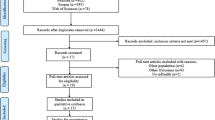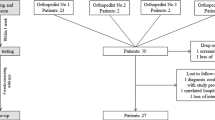Abstract
Purpose
Smartphone applications (SPApps) have become a key tool for the self-management of low back pain (LBP). However, the scientific evidence behind the outcome measures used in SPApps for LBP is never investigated before. Therefore, this systematic review firstly assess the quality of the free SPApps for LBP, secondly examines the outcome measures used and thirdly evaluates the outcome measures against the International Classification of Functioning, Disability and Health (ICF) core set classifications for LBP.
Methods
A systematic scoping review was conducted in the iTunes and Google Play™ on-line stores for LBP SPApps which are free to download. These searches were conducted using keywords suggested by the Cochrane Back and Neck Group. SPApps were screened and downloaded to assess the quality using the Mobile App Rating Scale (MARS). SPApps using outcome measures were reviewed separately to evaluate whether their outcome measures represented any of the ICF components for LBP.
Results
The overall quality of the apps has a mean MARS score of 2.5/5. Out of 74 apps reviewed, only four apps had outcome measures that could be linked to ICF components for LBP. Two of the four categories comprising the LBP core set were well represented.
Conclusion
The overall quality of the SPApps for LBP is low. Only very few SPApps offer outcome measures to monitor their effectiveness in the management of LBP. There is very limited evidence to show that the outcome measures used in the apps represents all the four core sets of LBP criteria set by ICF.


Similar content being viewed by others
References
Hoy D, March L, Brooks P, Blyth F, Woolf A, Bain C, Williams G, Smith E, Vos T, Barendregt J, Murray C. The global burden of low back pain: estimates from the Global Burden of Disease 2010 study. Ann Rheum Dis. 2014;73(6):968–74.
The Health and Safety Executive, 2017. Work-related musculoskeletal disorders (WRMSDs) statistics in Great Britain 2017. United Kingdom: The Health and Safety Executive (HSE). 2017. http://www.hse.gov.uk/Statistics/causdis/musculoskeletal/msd.pdf. Accessed 15 Dec 2017.
Maniadakis N, Gray A. The economic burden of back pain in the UK. Pain. 2000;84(1):95–103.
National Institute for Health and Clinical Excellence (NICE), 2016. Low back pain and sciatica in over 16s: assessment and management. London: National Institute for Health and Care Excellence (NICE): clinical guidelines. 2016. https://www.nice.org.uk/guidance/ng59/resources/low-back-pain-and-sciatica-in-over-16s-assessment-and-management-pdf-1837521693637. Accessed 10 Jan 2019.
Oliveira VC, Ferreira PH, Maher CG, Pinto RZ, Refshauge KM, Ferreira ML. Effectiveness of self-management of low back pain: systematic review with meta-analysis. Arthritis Care Res. 2012;64(11):1739–48.
Machado GC, Pinheiro MB, Lee H, Ahmed OH, Hendrick P, Williams C, Kamper SJ. Smartphone apps for the self-management of low back pain: a systematic review. Best Pract Res Clin Rheumatol. 2016;30(6):1098–109.
Selter A, Tsangouri C, Ali SB, Freed D, Vatchinsky A, Kizer J, Sahuguet A, Vojta D, Vad V, Pollak J, Estrin D. An mHealth App for self-management of chronic lower back pain (Limbr): pilot study. JMIR Mhealth Uhealth. 2018;6(9):e179. https://doi.org/10.2196/mhealth.8256.
de la Vega R, Miró J. mHealth: a strategic field without a solid scientific soul. A systematic review of pain-related apps. PLoS ONE. 2014;9(7):e101312.
West D. How mobile devices are transforming healthcare. Issues Technol Innov. 2012;18(1):1–11.
O’Sullivan K, O’Keeffe M, O’Sullivan P. NICE low back pain guidelines: opportunities and obstacles to change practice. Br J Sports Med. 2017;51:1632–3.
World Health Organization. International Classification of Functioning, Disability and Health: ICF. Geneva: World Health Organization (WHO). 2001. https://apps.who.int/iris/bitstream/handle/10665/42407/9241545429.pdf;jsessionid=1E3720813105A127AE35B58435C81602?sequence=1. Accessed 29 Mar 2019.
Lohmann S, Decker J, Mueller M, Strobl R, Grill E. The ICF forms a useful framework for classifying individual patient goals in post-acute rehabilitation. J Rehabil Med. 2011;43(2):151–5.
Cieza A, Stucki G, Weigl M, Disler P, Jackel W, van der Linden S, Kostanjsek N, de Bie R. ICF Core Sets for low back pain. J Rehabil Med. 2004;36:69–74.
Ewert T, Fuessl M, Cieza A, Andersen C, Chatterji S, Kostanjsek N, Stucki G. Identification of the most common patient problems in patients with chronic conditions using the ICF checklist. J Rehabil Med. 2004;36(1):22–9.
Deloitte Touche Tohmatsu Limited. mHealth in an mWorld How mobile technology is transforming health care. Washington DC, USA: Deloitte Center for Health Solutions. 2012. https://www2.deloitte.com/content/dam/Deloitte/us/Documents/life-sciences-health-care/us-lhsc-mhealth-in-an-mworld-103014.pdf. Accessed 20 Jan 2019.
Matters. App Market Stats. 2018. https://42matters.com/stats. Accessed 21 Jan 2019.
Haute Autorité de Santé. Good practice guidelines on health apps and smart devices. France: Haute Autorité de Santé (HAS). 2016. https://www.has-sante.fr/portail/upload/docs/application/pdf/2017-03/dir1/good_practice_guidelines_on_health_apps_and_smart_devices_mobile_health_or_mhealth.pdf. Accessed 2 Nov 2018.
Shamseer L, Moher D, Clarke M, Ghersi D, Liberati A, Petticrew M, Shekelle P, Stewart LA, the PRISMA-P Group. Preferred reporting items for systematic review and meta-analysis protocols (PRISMA-P) 2015: elaboration and explanation. BMJ. 2015;349:g7647.
Moher D, Shamseer L, Clarke M, Ghersi D, Liberati A, Petticrew M, Shekelle P, Stewart LA. Preferred reporting items for systematic review and meta-analysis protocols (PRISMA-P) 2015 statement. Syst Rev. 2015;4(1):1.
Furlan AD, Malmivaara A, Chou R, Maher CG, Deyo RA, Schoene M, Bronfort G, Van Tulder MW. 2015 updated method guideline for systematic reviews in the Cochrane Back and Neck Group. Spine. 2015;40(21):1660–73.
Apple, 2018. Guidelines. 2018. https://developer.apple.com/app-store/guidelines/. Accessed 18 Jan 2019.
Stoyanov SR, Hides L, Kavanagh DJ, Zelenko O, Tjondronegoro D, Mani M. Mobile app rating scale: a new tool for assessing the quality of health mobile apps. JMIR mHealth uHealth. 2015;3(1):e27.
Stanton R, Wintour SA, Kean CO. Validity and intra-rater reliability of MyJump app on iPhone 6s in jump performance. J Sci Med Sport. 2017;20(5):518–23.
Glocker C, Kirchberger I, Gläßel A, Fincziczki A, Stucki G, Cieza A. Content validity of the comprehensive international classification of functioning, disability and health (ICF) core set for low back pain from the perspective of physicians: a Delphi survey. Chronic Illn. 2013;9(1):57–72.
ICF Research Branch. ICF generic and rehabilitation sets. 2017. https://www.icf-research-branch.org/icf-core-sets-projects2/musculoskeletal-conditions/icf-core-set-for-low-back-pain. Accessed 28 Nov 2018.
Huckvale K, Car M, Morrison C, Car J. Apps for asthma self-management: a systematic assessment of content and tools. BMC Med. 2012;10(1):144.
Pandey A, Hasan S, Dubey D, Sarangi S. Smartphone apps as a source of cancer information: changing trends in health information-seeking behavior. J Cancer Educ. 2013;28(1):138–42.
Kuehnhausen M, Frost VS. Trusting smartphone apps? To install or not to install, that is the question. In: 2013 IEEE international multi-disciplinary conference on cognitive methods in situation awareness and decision support (CogSIMA). IEEE. App Review Service™. 2013. pp. 30–37. http://appiness.io/. Accessed 12 Dec 2018.
BinDhim NF, Hawkey A, Trevena L. A systematic review of quality assessment methods for smartphone health apps. Telemed e-Health. 2015;21(2):97–104.
McCartney M. How do we know whether medical apps work? BMJ. 2013;346:f1811.
Rodríguez MS, Vázquez SC, Casas PM, de la Cuerda RC. Neurorehabilitation and apps: a systematic review of mobile applications (English Edition). Neurología. 2016;33(5):313–26.
Santana MJ, Haverman L, Absolom K, Takeuchi E, Feeny D, Grootenhuis M, Velikova G. Training clinicians in how to use patient-reported outcome measures in routine clinical practice. Qual Life Res. 2015;24(7):1707–18.
Valdes K, Naughton N, Algar L. Linking ICF components to outcome measures for orthotic intervention for CMC OA: a systematic review. J Hand Ther. 2016;29(4):396–404.
Fayed N, Cieza A, Edmond Bickenbach J. Linking health and health-related information to the ICF: a systematic review of the literature from 2001 to 2008. Disabil Rehabil. 2011;33(21–22):1941–51.
Kaplan AL, Cohen ER, Zimlichman E. Improving patient engagement in self-measured blood pressure monitoring using a mobile health technology. Health Inform Sci Syst. 2017;5(1):4.
Author information
Authors and Affiliations
Corresponding author
Ethics declarations
Conflict of interest
The authors declare that they have no conflict of interest.
Additional information
Publisher's Note
Springer Nature remains neutral with regard to jurisdictional claims in published maps and institutional affiliations.
Rights and permissions
About this article
Cite this article
Coe-O’Brien, R., Joseph, L., Kuisma, R. et al. Outcome measures used in the smartphone applications for the management of low back pain: a systematic scoping review. Health Inf Sci Syst 8, 5 (2020). https://doi.org/10.1007/s13755-019-0097-x
Received:
Accepted:
Published:
DOI: https://doi.org/10.1007/s13755-019-0097-x




